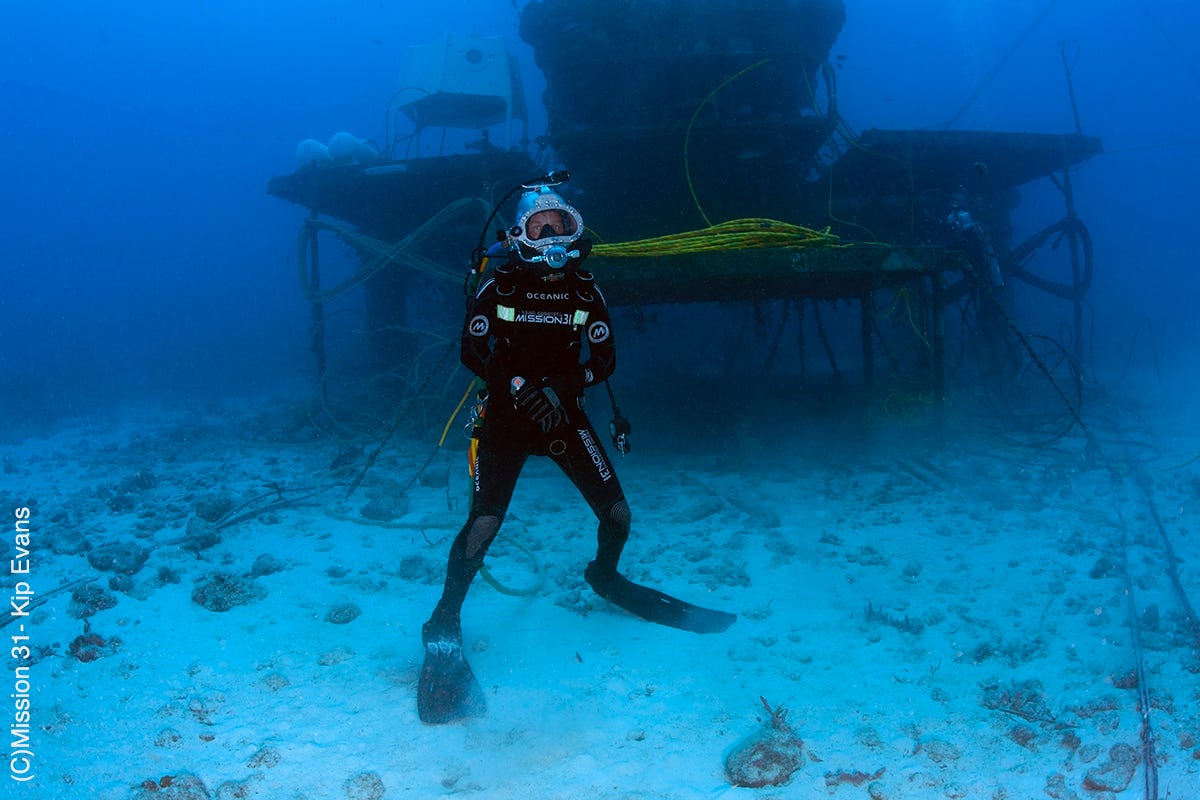Mission 31: A monthlong undersea adventure (pictures)
Fabien Cousteau and crew are set to surface after 31 days underwater. Get a glimpse of their aquatic life -- including encounters with goliath groupers and even a "vampire."

Fabien Cousteau
For the past month, Fabien Cousteau has led a team of aquanauts on a mission living and working at the world’s only undersea research lab, Aquarius. They're set to surface Wednesday. Mission 31 is similar to one his famous grandfather, Jacques Cousteau, undertook a little over 50 years ago. Click on to get a glimpse of what life was like during the 31-day undersea adventure.
Arriving at Aquarius
Fabien Cousteau arrives at Aquarius on June 1. The undersea lab is 63 feet below the surface in the Florida Keys National Marine Sanctuary. Aquanauts enter the habitat through what’s called a moon pool.
Mission 31 aquanauts
The first wave of aquanauts huddle around the table inside Aquarius. From left: Adam Zenone, Andy Shantz, Ryan LaPete, Mark Hulsbeck, Fabien Cousteau, and Kip Evans. Off to the right, you can see the bunks where they sleep.
Fabien and Jean-Michel Cousteau
Fabien gets a visit from his father and fellow ocean explorer Jean-Michel Cousteau.
A visit from 'Her Deepness'
Sylvia Earle, who Jean-Michel Cousteau calls “America’s Jacques Cousteau,” arrives at Aquarius. In 1970, Earle led the first all-female team of aquanauts on a research expedition as part of Tektite II.
An undersea Skype session
Fabien Cousteau has described Mission 31 as an "underwater classroom." He and his team shared their discoveries with viewers through daily Skype video calls with students around the world, live reports on the Weather Channel, and updates on social media.
Research, research, research
Scientific research was a big part of the expedition. The aquanauts, including Fabien Cousteau and Adam Zenone shown here, conducted research in areas ranging from predator-prey behavior to the effects of pollution and climate change on the health of the ocean.
A grouper named JYC
This goliath grouper that hangs around Aquarius is nicknamed JYC, in honor of Jacques-Yves Cousteau. He’s about 7 feet long and 300-plus pounds.
Visit from a 'vampire'
Ian Somerhalder, an actor (“Lost” and “Vampire Diaries”) and philanthropist, visited Aquarius.
Celebrating Jacques Cousteau
The crew celebrated Jacques Cousteau’s birthday on June 11. The famous ocean explorer, who was born in 1910 and lived until age 87, often donned a red cap.
Jacques Cousteau and his diving saucer
In this June 1963 photo, Jacques Cousteau is seen near his diving saucer in the Red Sea.
In the 1960s, Cousteau led a couple of experiments in undersea living. During Conshelf Two, about a half dozen oceanauts lived and worked in an undersea colony in the Red Sea for 30 days, while a support team worked above the surface. The Oscar-winning film "World Without Sun" chronicled their time underwater.
Window to an underwater world
A seat at the table at Aquarius gets you this view.
Undersea artwork
While visiting Fabien Cousteau (right), the artist Wyland, known for his works depicting marine life, paints a picture of Jacques Cousteau and Aquarius.
Night dive
Mission scientists Adam Zenone and Andy Shantz took along UV lights on a night dive.
Adrian Grenier
Aquanaut Grace Young greets actor Adrian Grenier (“Entourage”). Young was part of the second wave of aquanauts joining the mission, along with Liz Magee and Matthew Ferraro, at the midway point.
Underwater ballet
Aquanaut Grace Young’s ballet training emerges under the sea as she reaches for an upper shelf in the Aquarius habitat.
The Edgertronic
Aquanaut Liz Magee operates the Edgertronic camera, on loan from MIT. The camera, which shoots ultra high-speed video, was named for Harold “Doc” Edgerton, who was a pioneer in stop-motion photography. Jacques Cousteau was friends with the MIT professor -- “Papa Flash, as we used to call him on Calypso,” says Fabien Cousteau, who grew up on the decks of his grandfather’s boats.
Fabien and Jacques Cousteau
Fabien Cousteau on his grandfather's shoulders in 1970.
End of a mission
Cousteau looks out a porthole at Aquarius. At the end of the mission, the aquanauts “decompress” inside Aquarius, enabling them to exit the habitat and safely ascend to the surface. During decompression, which can take 16 to 18 hours, Aquarius is slowly brought to surface pressure, then repressurized quickly.

